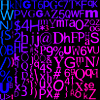10 cannot be divided by 3, so given 3 textures, you can already see that the textures must necessarily share some state, or some really mean bit whacking must take place. Without knowing more details or experimenting for a long time, it's hard to guess which one it is, though.
For example, it could be that there is the requirement that all three textures are the same size. That would mean storing 2 floats instead of 6 for size. Same is possible for scale, too (or scale could simply be uniform).
Packing half-precision floats into normal floats and integers is possible and has been done. GLM has functions for that kind of thing, and if I remember correctly, Cg even had functions (and hardware support on Kepler) for that. OpenGL's ARB_shading_language_packing does that kind of thing, too.
Also, as long as you do not need to interpolate this "float", you could in principle type-pun any collection of arbitrarily-sized integers as a float, for example 6 bits each for the POT size of a texture, and 10 bits each for a scale. After all, to the hardware, it's just a pattern of 32 bits (to some extent).
If textures are required to be power-of-two sized (quite possibly?), there are at most 16 or so possible sizes, thus you could easily pack the texture size into one float and still have room to encode rotation. Even if NPOT textures are allowed, assuming they're at most 2048x4096, they will fit into a float's mantissa no problem, precise to the pixel (with some hefty bit whacking one could fit 16kx16k textures in there too, but that's nasty).
Similarly, scale needs not use the full range of a float, it could very be two half-precision floats. Or, something else, two 16-bit integers type-punned as float, for example.








